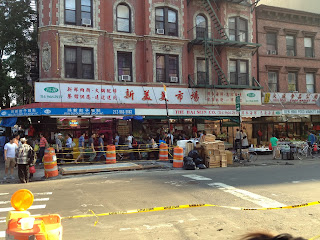Observer: Quanquan Chen
October 18, 2013, 1:00 pm-2:30 pm
October 18, 2013, 1:00 pm-2:30 pm
Type of bike lane: Dedicated bike lane, Class 1 and Class 2
Perceived safety: generally safe but lots of conflicts
Some locations in NYC have high frequency of conflicts between bicycles and other transportation modes, including freight vehicles (trucks and vans), passenger car, cabs, and pedestrians. Chrystie St (from E Houston St through Canal St, connecting Manhattan Bridge) and Grand St (from Centre St to Orchard St) are these kinds of location. I walked along both streets and spent more than 1 hour to observe.
 |
| Chrystie St Facing North |
 |
| Chrystie St Facing North |
 |
| Grand St Facing West |
During observation, I walked along Chrystie St from E Houston St to Grand St. Then I turned right (facing West) to walk along Grand St. Clearly marked dedicated bike lane are found in both streets except Grand St from Chrystie St to Bowery St. Clear bike lane in this interval was there before but has been worn away with time. Bike lane in Chrystie St and most lane in Grand St is designed as Class 2 bike lane without buffer area. Bike Lane settled in Grand St from Chrystie St to Bowery St is designed as Class 1 bike lane. It is a protected path separated by motor vehicle parking space.
High bicycle volumes, huge amount of pedestrian activities and truck activities were observed in both 2 streets, because Chrystie St is the corridor connecting Manhattan to Manhattan Bridge and both streets are located in China Town area, where land use types are commercial usage. Inconsistent bicycle traveling was observed in this area because of different types of conflicts between bicycle and: freight trucks or vans, passenger cars, pedestrian. Most big issues are found in Grand St from Chrystie St to Bowery St.
 |
| Truck parked in bike lane |
 |
| Passenger car parked in bike lane |
 |
| Public transit parked in bike lane temporally |
- Bike lane blockages: Freight vehicles and passenger cars parked in bike lane.
Freight vehicles and passenger cars parked in bike lane forcing bicyclists to share traffic lane with busy traffic. This is dangerous for cyclists especially in this high volume biking corridor.
There is strong relationship between the likelihood of a freight conflict and the share of retail businesses. The retail businesses along Chrysite St and Grand St create large amount of freight demand which generate conflicts between delivery trucks and bicycles. It was also been frequently observed that passenger car temporarily parked in the bicycle lane to buy grocery from retail stores along the streets.
 |
| Pedestrian walking on bike lane |
 |
| Delivery man using bike lane for delivery |
- Pedestrian walking on bike lane and delivery person using bike lane to transport goods by hand cart
 |
| Retail store use public sidewalk space for displaying their goods |
Because retail stores are using some public sidewalk space to display their goods, walking space for high volume pedestrians are narrowed. Many pedestrian chose to walk in bicycle lane. The result is that bicycle lane on Grand St was used as a sidewalk and lost its original function, bicyclist were forced to share traffic road with motor vehicles.
Based on what I saw, I would say that Class 1 bike lane (protected bike lane separated from traffic lane by motor vehicle parking lane) is not the appropriate design in such road where has high volume of activities.
To solve this problem, moving parking lane to curb side and creating an obstruction for pedestrian will be helpful. That is to change design of bicycle lane on Grand St from Class 1 to Class 2 with reserve delivery parking lots. But the most important measure is to require retail stores along Grand St to gather their goods back into their story instead of to use the public sidewalk space. Then effective enforcement should be guaranteed.
 |
| Bicyclists stopped for the signal |
- Cyclists do respect the signal but more than 50% of them did not wearing helmet
The thing I found is most of the bicyclists riding along Grand St did not wear helmet, but most bicyclists riding along Chrystie St did wear helmet. I guess the reason is that many people who use Chrystie St heading to Manhattan Bridge are professional bicyclists and they are more care about their safety. Most people who ride in Grand St are those people using bike as a temporary transport mode, they are not willing to spend much money on helmet.
 |
| Cyclist rode out of lane |
- Bicyclist riding out of lane without reasons
 |
| Unclear bike lane mark and many potholes |
- Terrible surface maintenance, painting of the lane was erased
This lane is the most misused lane. So I would say changing the configuration of this lane and painting it with bright green to enhance visibility will be very helpful to increase cycling safety and make it function better.
In summary, in the area I observed, many issues were found. The overall condition is safe for people to ride in here. According to high demand of commercial and cycling activities, enforcement need to be enhanced to regulate truck and passenger car parking, maintenance need to be done as soon as possible. I believe appropriate bike lane configuration and painting measure can serve this special area better.


No comments:
Post a Comment